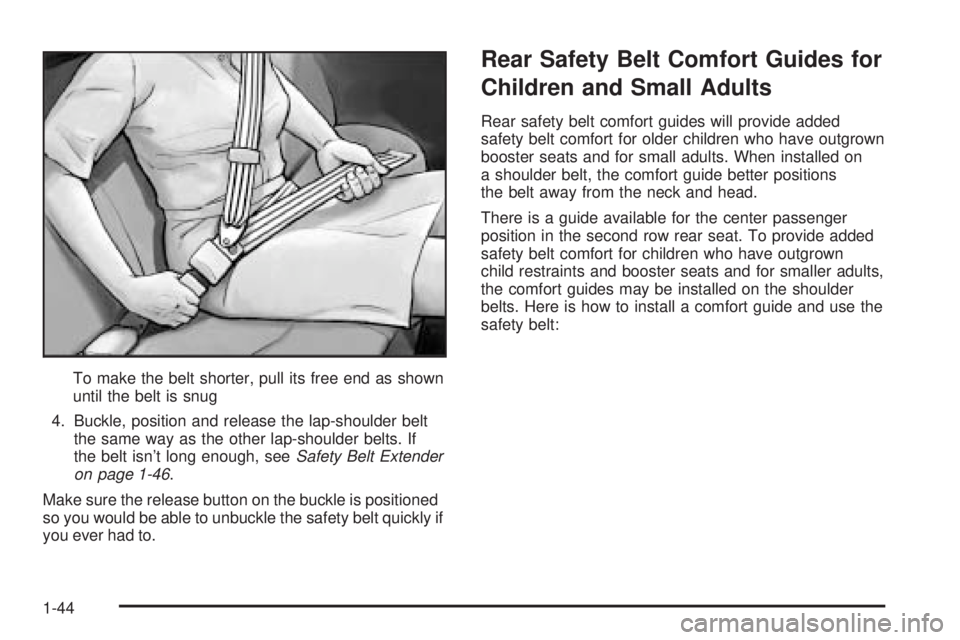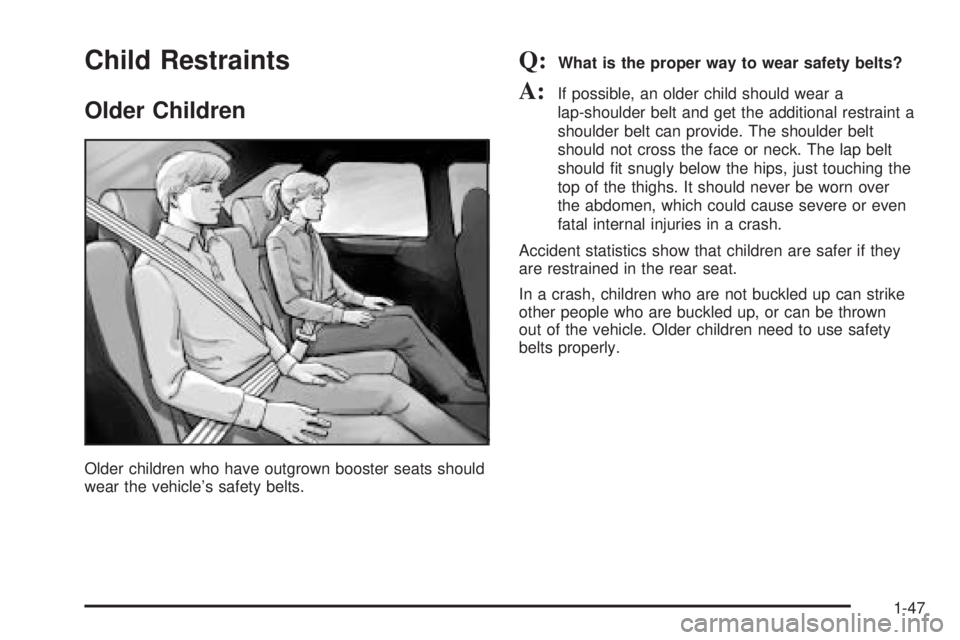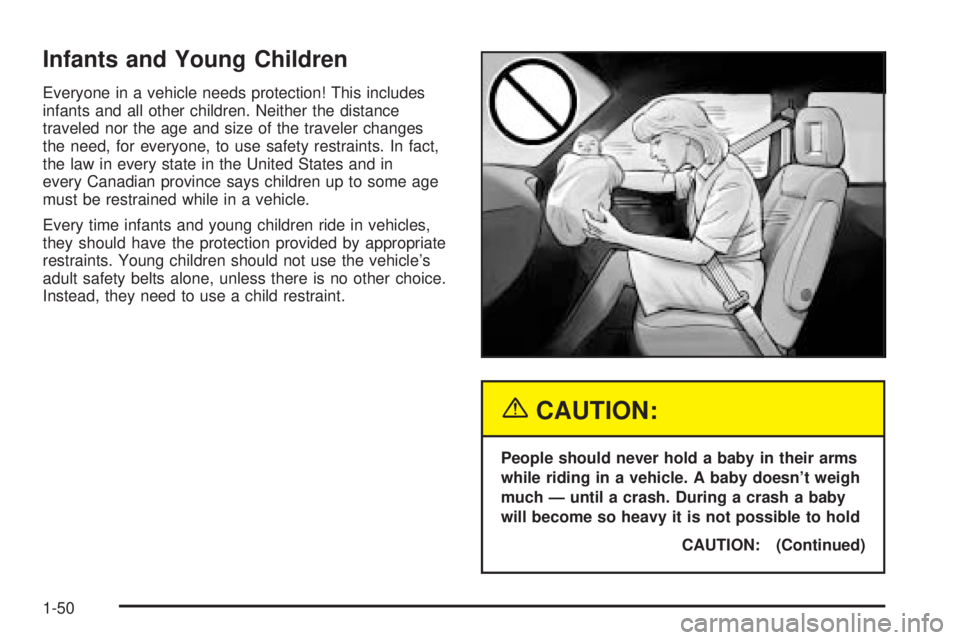2004 BUICK RANDEZVOUS child restraint
[x] Cancel search: child restraintPage 1 of 486

Seats and Restraint Systems........................... 1-1
Front Seats
............................................... 1-3
Rear Seats
............................................... 1-9
Safety Belts
.............................................1-22
Child Restraints
.......................................1-47
Air Bag Systems
......................................1-72
Restraint System Check
............................1-82
Features and Controls..................................... 2-1
Keys
........................................................ 2-3
Doors and Locks
....................................... 2-8
Windows
.................................................2-13
Theft-Deterrent Systems
............................2-15
Starting and Operating Your Vehicle
...........2-19
Mirrors
....................................................2-32
OnStar
®System
......................................2-33
HomeLink®Transmitter
.............................2-35
Storage Areas
.........................................2-39
Sunroof
..................................................2-48
Vehicle Personalization
.............................2-49
Instrument Panel............................................. 3-1
Instrument Panel Overview
.......................... 3-4
Climate Controls
......................................3-28
Warning Lights, Gages and Indicators
.........3-39
Message Center
.......................................3-50Driver Information Center (DIC)
..................3-60
Audio System(s)
.......................................3-73
Driving Your Vehicle....................................... 4-1
Your Driving, the Road, and Your Vehicle
..... 4-2
Towing
...................................................4-33
Service and Appearance Care.......................... 5-1
Service
..................................................... 5-3
Fuel
......................................................... 5-4
Checking Things Under the Hood
...............5-10
All-Wheel Drive
........................................5-48
Bulb Replacement
....................................5-50
Windshield Wiper Blade Replacement
.........5-55
Tires
......................................................5-57
Appearance Care
.....................................5-99
Vehicle Identi�cation
...............................5-107
Electrical System
....................................5-108
Capacities and Speci�cations
...................5-115
Maintenance Schedule..................................... 6-1
Maintenance Schedule
................................ 6-2
Customer Assistance Information.................... 7-1
Customer Assistance Information
.................. 7-2
Reporting Safety Defects
...........................7-11
Index................................................................ 1
2004 Buick Rendezvous Owner ManualM
Page 7 of 486

Front Seats......................................................1-3
Manual Passenger Seat..................................1-3
Four-Way Manual Driver Seat..........................1-3
Six-Way Power Seats.....................................1-5
Manual Lumbar..............................................1-5
Heated Seats.................................................1-6
Reclining Seatbacks........................................1-6
Head Restraints.............................................1-8
Rear Seats.......................................................1-9
Rear Seat Operation.......................................1-9
Split Bench Seats...........................................1-9
Captain Chairs.............................................1-14
Stowable Seat..............................................1-18
Safety Belts...................................................1-22
Safety Belts: They Are for Everyone................1-22
Questions and Answers About Safety Belts......1-26
How to Wear Safety Belts Properly.................1-27
Driver Position..............................................1-28
Safety Belt Use During Pregnancy..................1-36
Right Front Passenger Position.......................1-37
Rear Seat Passengers..................................1-38
Center Rear Passenger Position.....................1-42Rear Safety Belt Comfort Guides for Children
and Small Adults.......................................1-44
Safety Belt Pretensioners...............................1-46
Safety Belt Extender.....................................1-46
Child Restraints.............................................1-47
Older Children..............................................1-47
Infants and Young Children............................1-50
Child Restraint Systems.................................1-53
Where to Put the Restraint.............................1-56
Top Strap....................................................1-57
Top Strap Anchor Location.............................1-58
Lower Anchorages and Top Tethers for
Children (LATCH System)...........................1-62
Securing a Child Restraint Designed for the
LATCH System.........................................1-64
Securing a Child Restraint in a Rear Outside
Seat Position............................................1-64
Securing a Child Restraint in a Center Rear
Seat Position............................................1-67
Securing a Child Restraint in the Right Front
Seat Position............................................1-69
Section 1 Seats and Restraint Systems
1-1
Page 33 of 486

Q:If I’m a good driver, and I never drive far from
home, why should I wear safety belts?
A:You may be an excellent driver, but if you’re in an
accident – even one that isn’t your fault – you and
your passengers can be hurt. Being a good
driver doesn’t protect you from things beyond your
control, such as bad drivers.
Most accidents occur within 25 miles (40 km) of
home. And the greatest number of serious injuries
and deaths occur at speeds of less than 40 mph
(65 km/h).
Safety belts are for everyone.
How to Wear Safety Belts Properly
This part is only for people of adult size.
Be aware that there are special things to know about
safety belts and children. And there are different
rules for smaller children and babies. If a child will be
riding in your vehicle, seeOlder Children on page 1-47
orInfants and Young Children on page 1-50. Follow
those rules for everyone’s protection.
First, you’ll want to know which restraint systems your
vehicle has.
We’ll start with the driver position.
1-27
Page 50 of 486

To make the belt shorter, pull its free end as shown
until the belt is snug
4. Buckle, position and release the lap-shoulder belt
the same way as the other lap-shoulder belts. If
the belt isn’t long enough, seeSafety Belt Extender
on page 1-46.
Make sure the release button on the buckle is positioned
so you would be able to unbuckle the safety belt quickly if
you ever had to.
Rear Safety Belt Comfort Guides for
Children and Small Adults
Rear safety belt comfort guides will provide added
safety belt comfort for older children who have outgrown
booster seats and for small adults. When installed on
a shoulder belt, the comfort guide better positions
the belt away from the neck and head.
There is a guide available for the center passenger
position in the second row rear seat. To provide added
safety belt comfort for children who have outgrown
child restraints and booster seats and for smaller adults,
the comfort guides may be installed on the shoulder
belts. Here is how to install a comfort guide and use the
safety belt:
1-44
Page 53 of 486

Child Restraints
Older Children
Older children who have outgrown booster seats should
wear the vehicle’s safety belts.
Q:What is the proper way to wear safety belts?
A:If possible, an older child should wear a
lap-shoulder belt and get the additional restraint a
shoulder belt can provide. The shoulder belt
should not cross the face or neck. The lap belt
should �t snugly below the hips, just touching the
top of the thighs. It should never be worn over
the abdomen, which could cause severe or even
fatal internal injuries in a crash.
Accident statistics show that children are safer if they
are restrained in the rear seat.
In a crash, children who are not buckled up can strike
other people who are buckled up, or can be thrown
out of the vehicle. Older children need to use safety
belts properly.
1-47
Page 54 of 486

{CAUTION:
Never do this.
Here two children are wearing the same belt.
The belt can’t properly spread the impact
forces. In a crash, the two children can be
crushed together and seriously injured. A belt
must be used by only one person at a time.
Q:What if a child is wearing a lap-shoulder belt,
but the child is so small that the shoulder belt
is very close to the child’s face or neck?
A:If the child is sitting in a seat next to a window,
move the child toward the center of the vehicle.
If the child is sitting in the center rear seat
passenger position, move the child toward the
safety belt buckle. In either case, be sure that the
shoulder belt still is on the child’s shoulder, so
that in a crash the child’s upper body would have
the restraint that belts provide.
If the child is sitting in a rear seat, seeRear Safety
Belt Comfort Guides for Children and Small
Adults on page 1-44.
1-48
Page 56 of 486

Infants and Young Children
Everyone in a vehicle needs protection! This includes
infants and all other children. Neither the distance
traveled nor the age and size of the traveler changes
the need, for everyone, to use safety restraints. In fact,
the law in every state in the United States and in
every Canadian province says children up to some age
must be restrained while in a vehicle.
Every time infants and young children ride in vehicles,
they should have the protection provided by appropriate
restraints. Young children should not use the vehicle’s
adult safety belts alone, unless there is no other choice.
Instead, they need to use a child restraint.
{CAUTION:
People should never hold a baby in their arms
while riding in a vehicle. A baby doesn’t weigh
much — until a crash. During a crash a baby
will become so heavy it is not possible to hold
CAUTION: (Continued)
1-50
Page 57 of 486

CAUTION: (Continued)
it. For example, in a crash at only 25 mph
(40 km/h), a 12-lb. (5,5 kg) baby will suddenly
become a 240-lb. (110 kg) force on a person’s
arms. A baby should be secured in an
appropriate restraint.
{CAUTION:
Children who are up against, or very close to,
any air bag when it in�ates can be seriously
injured or killed. Air bags plus lap-shoulder
belts offer outstanding protection for adults
and older children, but not for young children
and infants. Neither the vehicle’s safety belt
system nor its air bag system is designed for
them. Young children and infants need the
protection that a child restraint system can
provide.
1-51